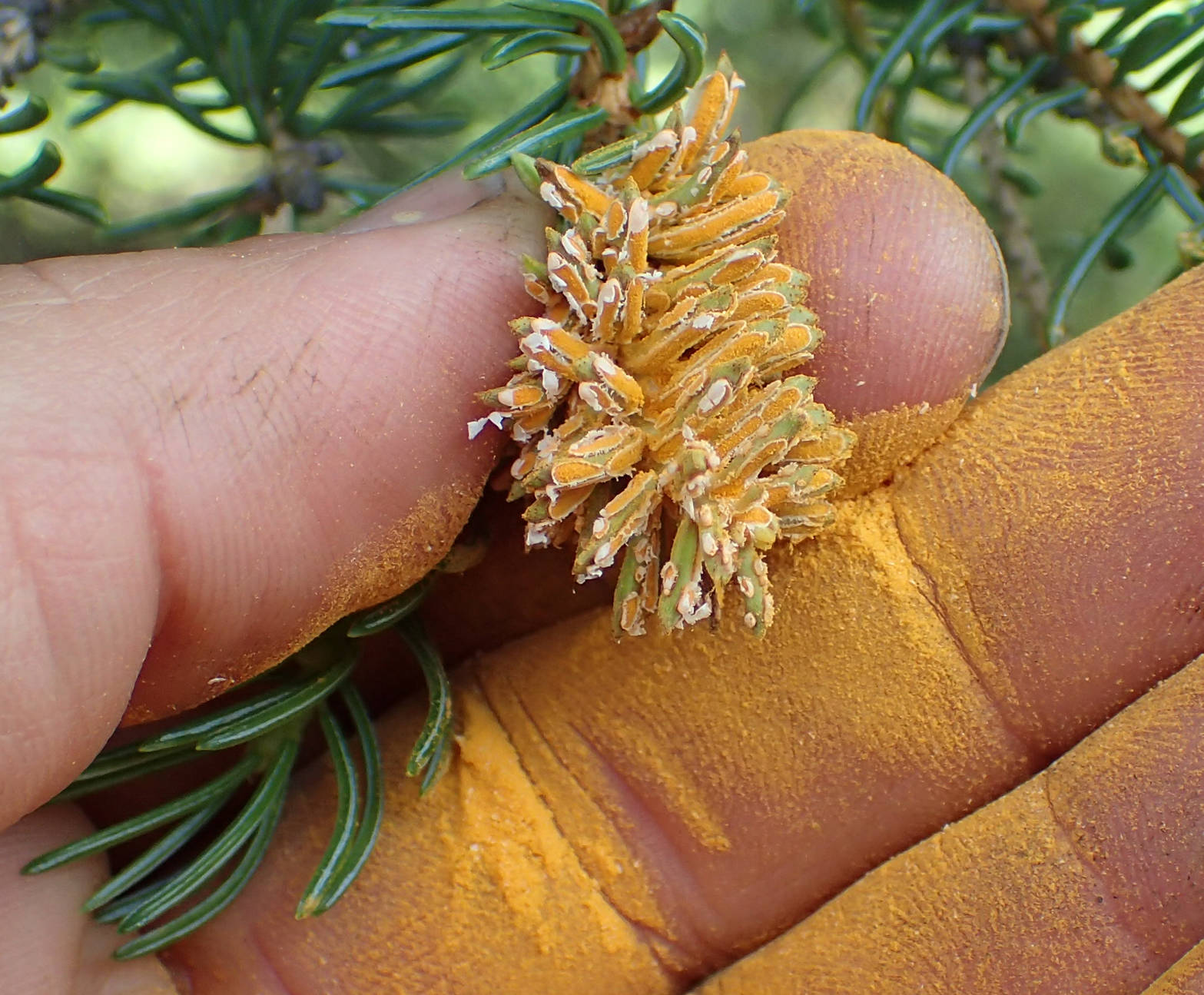By MATT BOWSER
“What is that?” asked my co-worker, pointing down to where it looked like someone had marked the ground beside the Skyline Trail with neon orange spray paint. It turned out to be an orange powder coming from a fallen spruce cone. As we looked around we saw strangely stunted, bright orange spruce tips that dropped copious orange powder whenever they were touched. These were spores of a rust fungus.
Rust fungi, named for the rust-colored spores of some species, include thousands of species, all of them parasites wholly dependent on their plant hosts. Each kind of rust fungus usually infects only one to a few species of plants.
Rusts are familiar diseases on our local spruces, with multiple species of spruce rusts known in our area, but these bright orange spruce tips were different than anything I could find in field guides. I sent pictures to Dr. Lori Winton, Forest Pathologist at the U.S. Forest Service’s Forest Health Protection office in Anchorage. She quickly identified the photos as spruce tip rust, Chrysomyxa woroninii.
Although this fungus was described in 1903, the details of its biology have been worked out only recently. To complete its life cycle, spruce tip fungus requires two host plants: a spruce and bog Labrador tea (Ledum groenlandicum), a shrub common in wetlands and woods in our area.
By the time this article is printed, infected spruce tips will have released most of their spores and have started to change from orange to brown to black as the tips die and release a special kind of spore called aeciospores. In the case of spruce tip rust, the aeciospores are incapable of reinfecting spruce. They must be spread by wind, water or animals to bog Labrador tea, their primary host.
The aeciospores germinate on Labrador tea, sending out filaments that penetrate and ramify through the host plant’s tissues. The fungus grows by extracting nutrients from its host’s cells. The infection causes a stunted, irregular growth of dense branches called a “witches’ broom.” The rust lives through the winter inside the leaves of Labrador tea. In spring, spore-producing structures erupt from undersides of infected leaves, releasing a different kind of spore called teliospores.
The teliospores are dispersed by wind and rain. They germinate and release yet another kind of spore called basidiospores, which can only infect spruce. Basidiospores that germinate on spruce send out filaments that penetrate the spruce, presumably through microscopic holes on the needles called stomata. This leads to a local systemic infection, where the fungus grows within the tissues of a new spruce tip bud that develops in the late summer.
The spruce tip rust fungus overwinters in the spruce buds. As the tips begin to elongate in the spring, infected tips develop into spore-producing factories, with all needles in the spruce tips eventually bursting with spores. This life cycle takes two years to complete, so the infected spruce tips we see this year were infected last summer.
Female cones of spruce can be infected by Chrysomyxa woroninii, basically hijacking the cones so that they produce orange fungal spores instead of viable seeds. (Locally, spruce cones can also be infected with spruce cone rust, another species of Chrysomyxa that alternates between wintergreens and spruce cones.)
Although spruce tip rust is strikingly conspicuous this year on black, white and Lutz spruce on the Kenai Peninsula (I have not yet investigated Sitka spruce), its effects on spruces appear to be quite inconsequential. Most trees that I see lack any obviously affected tips and infected trees usually have few orange tips, perhaps one in 100 tips.
Spruce tip rust is generally not an important disease of spruce, usually causing little slowing of growth, but sometimes causing a significant reduction in viable seed production. The fungus does not continue living in its spruce host but dies as the infected tips dry up, requiring Labrador tea to complete another round of its life cycle and reinfect spruce the following summer.
Throughout its range in the boreal forest of the Old World and New World where both spruces and Labrador tea occur, Chrysomyxa woroninii tends to be seldom seen. It appears that even where it is present, this fungus requires a specialized set of conditions to complete its life cycle. There is some evidence that infections of spruce are more frequent following rainy summers, with the spores apparently having a better chance of infecting developing spruce buds in wet conditions. This year’s comparatively high incidence of spruce tip rust on spruce is likely related to the wet, rainy summer of 2017.
If you have not yet seen spruce tip rust fungus, have a look at this phenomenon soon before these orange tips turn completely brown and are only a memory. It is likely that Chrysomyxa woroninii will again be rarely seen in our area for some time as we move past the most conspicuous phase of this one of many cycles of nature.
Matt Bowser serves as Entomologist at Kenai National Wildlife Refuge. Find more Refuge Notebook articles (1999-present) at https://www.fws.gov/refuge/Kenai/community/refuge_notebook.html.

